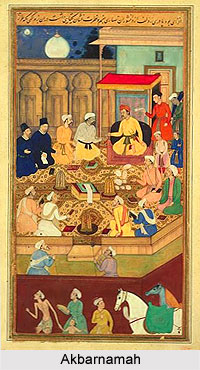 Akbarnamah was penned by Abul Fazl Allami who was a friend, courtier and a court historian in the reign of the greatest Mughal monarch Akbar and is till date the greatest work in the whole series of historical literature in the Indian subcontinent. The `Akbarnamah` is a Persian term and it literally means the `history of Akbar`. In fact the author of this book was considered as one of the Nine Jewels or `Navaratnas` in the royal court of Akbar. The book was commissioned by Emperor Akbar and took seven long years to be completed. Besides the vital information the book also consisted of a number of paintings supporting the texts and some other representing the Mughal School of Painting. The famous work Akbarnamah has come down to the following generations three volumes. The first volume relates the history of Timur`s family, the glorious monarchy of Babur and Humayun, the birth of Akbar, his accession to the throne and his reign till the seventeenth year and also about the Sur Sultans of Delhi. The second volume of Akbarnamah deals with detailed information on the history of Akbar`s reign from the eighteenth year up to the 46th year of his rule. It was during this year that the death of Abul Fazl Allami took place and the book stops there. The third volume relates information on the Ain-i-Akbari, which is again a conglomeration of the administrative account of the Mughal empire during Akbar`s reign as well as the famous "Account of the Hindu Sciences". He also speaks on the views that the orthodox Muslims held against the Hindus on the issues of polytheism and idolatry as well as the caste system prevalent during that time and the doctrine of Karma.
Akbarnamah was penned by Abul Fazl Allami who was a friend, courtier and a court historian in the reign of the greatest Mughal monarch Akbar and is till date the greatest work in the whole series of historical literature in the Indian subcontinent. The `Akbarnamah` is a Persian term and it literally means the `history of Akbar`. In fact the author of this book was considered as one of the Nine Jewels or `Navaratnas` in the royal court of Akbar. The book was commissioned by Emperor Akbar and took seven long years to be completed. Besides the vital information the book also consisted of a number of paintings supporting the texts and some other representing the Mughal School of Painting. The famous work Akbarnamah has come down to the following generations three volumes. The first volume relates the history of Timur`s family, the glorious monarchy of Babur and Humayun, the birth of Akbar, his accession to the throne and his reign till the seventeenth year and also about the Sur Sultans of Delhi. The second volume of Akbarnamah deals with detailed information on the history of Akbar`s reign from the eighteenth year up to the 46th year of his rule. It was during this year that the death of Abul Fazl Allami took place and the book stops there. The third volume relates information on the Ain-i-Akbari, which is again a conglomeration of the administrative account of the Mughal empire during Akbar`s reign as well as the famous "Account of the Hindu Sciences". He also speaks on the views that the orthodox Muslims held against the Hindus on the issues of polytheism and idolatry as well as the caste system prevalent during that time and the doctrine of Karma.
The importance of Akbarnamah is beyond interpretation as it is the principle source of information for reconstructing the history of Mughal campaigns in Bengal during the reign of the greatest Mughal monarch. One can avail all the information on the history of Mughal warfare from this great historical account. In this great work we also get a clear and relevant picture about the various attempts of Akbar to subjugate Bengal and also the various activities of the generals sent by him for the particular purpose together with the resistance offered by the zamindars, bhuiyans and the chiefs of Bengal. This book also relates to all about the mutiny of Mughal captains in Bengal, which was continued for two years for several reasons, the first reason being the introduction of the Din-i-Illahi and the second being the reduction in allowances of military chiefs of Bengal.
On the eve of Mughal conquest, the Akbarnamah also forms an important source about the political condition of Bengal and also the identification of the bhuiyans and zamindars who revolted against the imperial reign of the famous Mughal monarchs. The early reigns of the Bengal chiefs including Kedar Rai, Isa Khan Khwaja Usman and others are also available in this historical account. The information being sketchy and short is also quite dependable and provides us with the essential details. Along with the help of other indigenous and local sources including coins, traditions and inscriptions the history of the Bengal chiefs and zamindars can be reconstructed with considerable accuracy. The Akbarnamah is in fact regarded as the most reliable source for preparing the chronology of the span of Akbar`s monarchy.



















